This is a Contessa 35 (model 533/24), a compact folding 35mm rangefinder camera made in Stuttgart, Germany by Zeiss-Ikon between the years 1950 and 1955. The Contessa was designed as a premiere fixed lens compact folding camera that had the features and quality of the best of what Germany could offer at the time. The unique rangefinder system used a rotating piece of glass that needed no physical connection to the main body of the camera meaning it could be folded shut without any risk of damage. The camera was very well built and very expensive, however this likely kept sales low as the camera was only in production for 5 years.
 Film Type: 135 (35mm)
Film Type: 135 (35mm)
Lens: 45mm f/2.8 Zeiss-Opton Tessar coated 4-elements
Focus: 0.8 meters to Infinity
Viewfinder: Coincident Image Coupled Rangefinder
Shutter: Compur-Rapid Leaf
Speeds: B, 1 – 1/500 seconds
Exposure Meter: Uncoupled Selenium Cell w/ top plate readout
Battery: None
Flash Mount: Coldshoe with X Flash Sync Port
Weight: 605 grams
Manual: http://www.cameramanuals.org/zeiss_ikon/zeiss_ikon_contessa.pdf
Please Read: This review was originally published in March 2018 using a Zeiss-Ikon Contessa 35 with major problems. In the months and years since this review, several readers have contacted me saying I wasn’t fair to this camera.
One such reader, offered to send me his perfectly working example to see what shooting a good Contessa was like. In January 2021, I published my Second Look on the Zeiss-Ikon Contessa 35 that I hope will right a few wrongs.
https://mikeeckman.com/2021/01/second-look-zeiss-ikon-contessa-35/
I am leaving this original review online as it goes more in depth into the history, use, and some basic repair info that I did not duplicate in that newer review.
History
The Carl Zeiss Foundation has a long and rich history that dates back to the 1800s which I’ve covered in other reviews for cameras like the Zeiss-Ikon Nettar 515 and Zeiss-Ikon Icarette 500/15. If you’d like to know more, I suggest reading the history sections in those articles.
 For this article, I’ll start at the end of World War II when Zeiss-Ikon Dresden was split into separate Zeiss-Ikon companies, one based in Stuttgart, West Germany, and the other in Dresden, East Germany. An agreement between the Allied controlled West German government and Soviet controlled East German government allowed both companies to use the Zeiss-Ikon name, but trademark disputes were common throughout the entire brand. For a short while after the war, the West German company was named Zeiss-Opton Optische Werke Oberkochen GmbH, but soon changed back to Zeiss-Ikon after relocating to Stuttgart.
For this article, I’ll start at the end of World War II when Zeiss-Ikon Dresden was split into separate Zeiss-Ikon companies, one based in Stuttgart, West Germany, and the other in Dresden, East Germany. An agreement between the Allied controlled West German government and Soviet controlled East German government allowed both companies to use the Zeiss-Ikon name, but trademark disputes were common throughout the entire brand. For a short while after the war, the West German company was named Zeiss-Opton Optische Werke Oberkochen GmbH, but soon changed back to Zeiss-Ikon after relocating to Stuttgart.
In the late 1940s, Germany was still heavily battered from the war, and the rest of the world did not see Germany as a respected economic power, but any reservations the rest of the world had towards German produced items seemingly did not apply to German cameras and other optical goods. German cameras were highly prized souvenirs by Allied soldiers during the war, and afterwards the demand for quality built German cameras was very high.

The Contessa-Nettel factory in Stuttgart, which Zeiss acquired in it’s 1926 merger, was largely spared damage from the war and was the only one of Zeiss’s major facilities that would not fall under control from the Soviet government, so it was chosen as the logical site for a West German Zeiss resurgence. The Contessa factory was the smallest of the 4 major Zeiss-Ikon factories in pre-war Germany and had the least number of employees.
In the first few years after the war, 100% of the production from the Stuttgart factory was handed over to the American military and were sold via the military’s PX retail stores. In my research for this article, I came across an interesting story where at first, American officers would pay Zeiss for their cameras using cash, but later would give them a blank check which would be filled in for whatever amount the company wanted to charge. Due to the small size of the Stuttgart factory, Zeiss struggled to keep up with demand. It wasn’t until around 1951 when a couple of new buildings were built next to the original factory to increase production.
Prior to the war, most of Zeiss-Ikon’s design work was done at the Dresden factory and it was there where the majority of new cameras were created. The Stuttgart factory produced most of Zeiss’s compact roll film cameras like the Ikonta and Nettar series, so those were the first models to resume production.
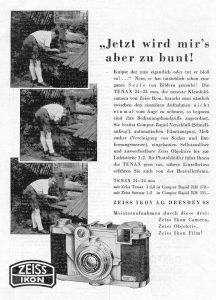
Shortly after resuming production of these models, Zeiss-Ikon sought to revive the reputation of the Zeiss brand by releasing a series of compact new 35mm cameras designed by famed designer Hubert Nerwin. Nerwin had been a Zeiss employee since before the war, and is credited for some of the brand’s most successful designs, including the Contax II and III rangefinder, Contaflex SLR, the Super Nettel, and Tenax compact camera.
During the war, Nerwin had been focused on the German war effort and adapted some existing Zeiss bodies in use for war photography. It was clear before the war that compact 35mm cameras like the Leica and Contax would continue to rise in popularity and would be the future of the company so during his free time, Nerwin worked on several new compact 35mm prototypes. Sadly, all of his war-time prototypes were destroyed in the bombing of Dresden, but it would be these ideas that he had in his head which he would later develop in Stuttgart.
Shortly before the end of the war when it was obvious Germany was losing, Nerwin fled Germany and took his family back to Austria where he was originally from, and rode out the rest of the war in hiding. After the war, he made his way to Stuttgart where he had hoped to re-join Zeiss-Ikon and continue his work there.
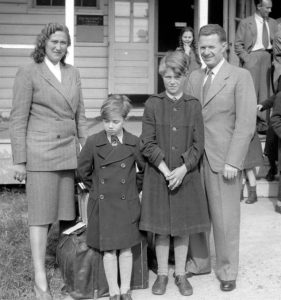
When Nerwin arrived at the Contessa factory, he was initially turned away by the French occupation that was short lived in that era, but once the Americans moved in, he was welcomed and put into a position where he could help rebuild the reputation of Zeiss-Ikon. It was important for Zeiss-Ikon to put into production new 35mm models, but the company’s Contax rangefinders were too complex for the small Stuttgart factory to handle so they had to come up with something else.
Hubert Nerwin would only work in Stuttgart for 2 years, but in that time he put into production three different compact 35mm cameras that were based off his prototypes that he had developed in Dresden during the war. He would leave Germany in 1947 for the United States where he and his family would eventually relocate in Rochester, NY where he would eventually work for Kodak and Graflex.
The first of Nerwin’s models to be produced was the Ikonta 35, a simple yet elegant compact 35mm scale focus folding camera. After the Ikonta 35 went into production, a variant of that camera with an uncoupled rangefinder on the top plate was released called the Contina. Sharing the same basic shape and bottom hinged front door, the Contina was still quite compact and inexpensive compared to other 35mm rangefinders of the day like the company’s own Contax rangefinder and those made by Leitz. Shortly after the release of both the Ikonta 35 and the Contina, the two cameras were renamed, the Ikonta 35 became the Contina I and the Contina became the Contina II.
While both the Ikonta 35 and Contina cameras were well built cameras, Nerwin had an idea for a top of the line compact 35mm rangefinder that would compete with the best cameras of the day, specifically the Kodak Retina that was built nearby in Stuttgart at the Kodak Nagel-Werke factory. This new camera should still be small and pocketable, but have the best optics and build quality the company was capable of to directly compete with the Retina and models being released by Leitz and other companies.

This new top of the line camera would get it’s name from the old Contessa-Nettel factory where it was made. The Contessa 35 would be released in 1950, three years after Hubert Nerwin had left Germany for America. The camera, although seen as a success, sold modestly. According to the Zeiss Historica Society, it’s list price in May 1950 was $188 and that climbed to $214 in October 1952, before dropping to $142 in April 1954. These prices when adjusted for inflation are comparable to $1975, $1995, $1319 respectively, today.
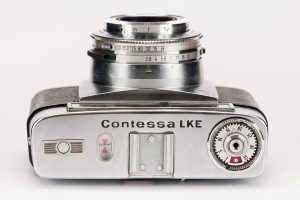
The Contessa 35 was produced until 1955 and only saw one revision in 1953, which was the inclusion of an improved Synchro-Compur shutter with both M and X flash sync. After it was discontinued, Zeiss would once again use the name “Contessa” starting in 1960 with an unrelated line of non-folding solid bodied 35mm cameras.
In my research for this article, I could not find any information about how many of these cameras were made, but I have to imagine the numbers weren’t very high. The Contessa 35 never reached the popularity of the Kodak Retina to which it was partially designed to compete against. This could be due to a number of reasons, most likely distribution. Although built in Germany, the entire lineup of Retina cameras had a very well known US company behind them which included a very large and established distribution network. Also helping the Retina’s cause was brand recognition, as there were a variety of different Retina models from the basic scale focus Retina I-series, the rangefinder only II-series, and the rangefinder and light meter equipped III-series.
Today, the Zeiss-Ikon Contessa 35 remains a very popular camera for collectors. Prices on these in good condition can reach several hundred dollars. They are precision built and complex cameras however, so if you encounter one that needs work, they are quite difficult and expensive to repair. If you are simply looking to display one on a shelf, you’ll save a lot of money by picking up a broken one as it’s price will reflect the difficulty in repairing it, but if you expect to use one of these, expect to pay a premium for a working copy.
My Thoughts
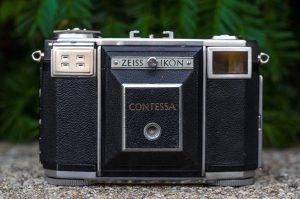
The Zeiss-Ikon Contessa 35 was designed as a premiere compact 35mm camera to compete with other highly regarded German made compact 35mm folding cameras like the Kodak Retina and Voigtlander Vitessa. These were all precision made, fully mechanical cameras that were thought to offer the best of what Germany had to offer in the fixed lens folding segment.
I’ve never had the privilege of handling a Vitessa, so I can only speculate about the experience, but I have held and shot my fair share of Retinas. Compared to a Retina IIa which was produced during the bulk of the same time period as the Contessa, the Contessa seems almost exotic. The Retina had the edge with an available 6-element f/2 Schneider Xenon lens compared to the 4-element f/2.8 Tessar, but the Contessa had a few things that the Retina didn’t, such as a selenium light meter, something the Retina series wouldn’t see until the IIIc in 1954.
The Zeiss Tessar f/2.8 had a front focusing element instead of a more complex helical focus like the Kodak Retina. This choice was made to keep costs low, to simplify the design of the lens mount, and allow it to be easily adapted to existing Compur shutters. The Tessar lens accepts both 27mm screw in and 32mm slip on filters, and were compatible with those already being made for the Contaflex SLR.
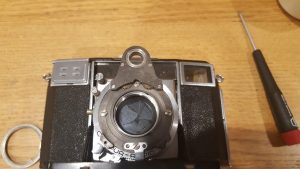
The Contessa has a bottom hinged front door with a self erecting lens and shutter with a box completely covering the folding bellows. A fully covered bellows box would appear on the Retina IIc and IIIc in 1954 as well. The rangefinder system was unique on the Zeiss. Using a system involving a rotating piece of wedge-shaped glass contained in a circular frame attached to the shutter, the Contessa’s rangefinder had no mechanical connection between the lens and the body. In the image to the left, you can see two small brass gears immediately above the shutter. These gears are normally connected to a larger gear on the back of the focus wheel that when rotated, are connected to the rotating rangefinder glass. This proved to be beneficial as there was nothing to bend or break when folding the camera shut. The design of the door on the Contessa meant that the camera can be closed regardless of the position of the lens. Retinas famously must be set to infinity before closing the camera, or else you risk damaging something.

Inside of the camera, Zeiss took no shortcuts. The rangefinder assembly in the Contessa is a solid piece of prism glass and uses no mirrors, ensuring a bright and accurate path for the light to travel through to the coincident image viewfinder. The shutter was a Compur-Rapid on the early models and a Synchro Compur on the later ones all with top speeds of 1/500 seconds.
It seemed that Zeiss-Ikon spared no expense to make the most advanced and feature rich camera they could, and they succeeded…mostly.
Where Zeiss turned the Contessa to 11 so to speak, they also complicated the design. I found the ergonomics of the Contessa to be less than desirable. For one, to focus the camera requires you to position your left thumb and forefinger around the lens while still supporting the camera and turning a knurled ring around the perimeter of the lens. In the next image, the focus ring is indicated by the YELLOW arrow which I found to be awkward every time I was shooting the camera. Once I would manage to get my hand in the correct position it was fine, but locating it’s position never felt automatic each time I’d lower the camera and prepare for the next exposure. I always had to take the camera from my eye, look at the front of it, position my hand, and then put it back to my eye.
Like all Compur shutters, changing shutter speeds requires rotating a ring around the collar of the shutter, which in the image to the left is indicated by the RED arrow. Unlike most Compurs, there are a number of things like the shutter release and flash sync port that obstruct a natural location for your hand to grip this ring to change speeds. Changing the f/stop is even worse. This requires a precise movement of a very thin piece of metal at the very base of the shutter where it meets the body of the camera, indicated by the BLUE arrow. In the image to the left, you can see the shutter ring is set to 250 and the aperture is set to 11.
The Contessa requires the shutter to be manually cocked before you make an exposure, and do that, you need to manually press the smaller elongated knurled lever, indicated by the PURPLE arrow. Finally, when it’s time to release the shutter, you press down on the larger elongated knurled lever, indicated by the GREEN arrow.
All of the primary controls of the camera are crammed together in a very small area fighting for space. This was a big issue for me and I found the ergonomics and general controls of the Retina to be far superior in this regard.
As somewhat of a compromise to the complexity of these settings, the Contessa has 2 dots, one of which you can see in the previous image above between the shutter speed 1/25 and f/8, and a second on the focus wheel to the left of the 6 meter mark that when set at these red dots, the camera becomes a sort of “focus free” camera where everything from 8 feet to infinity will be in focus. Although 1/25 of a second is a bit too slow for stable hand held shots, using modern high speed film with a faster shutter speed but still the same focus setting and f/8 aperture, you can duplicate the same result negating the need to mess with these controls.
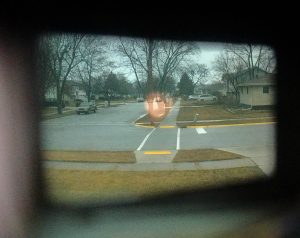
The viewfinder is quite small, but consistent with other rangefinders designed around 1950. I compared it in size to that of my Retina IIa and they were nearly identical in size and brightness. The Zeiss employs a green filter in the main viewfinder window to increase contrast with the clear rangefinder patch. An oddity of the viewfinder is that due to the front glass being on a slant, the image through the viewfinder takes on a trapezoidal shape, and with the lack of projected frame lines, this makes composing an accurate 50mm image difficult. In the image to the right, notice the angled lines of the viewfinder. This was not due to how I took the photo, that’s how it really looks.
Edit 11/15/2019: In the time since writing this review, I have come to learn that the strange trapezoidal shape of the viewfinder is not how it’s supposed to be. There appears to be some kind of mask that is missing or damaged within the viewfinder of the camera I reviewed for this article. I have been assured by other owners of this camera that what you see through the viewfinder should accurately represent a normal 50mm image. I have yet to come across another example of this camera, but if I do, I will be certain to get a better image and further update this review.

The top plate of the camera is dominated on the right side by the uncoupled selenium meter and exposure calculator scale. There is a door on the front of the camera in front of the meter that needed to flip up when used in low light situations.
The meter on my example was dead, so I did not use it, but had it been working it is of the type where you calculate a reading based on available light, and using the dials, translate that into appropriate shutter speeds and aperture settings which you have to manually change on the camera. This is consistent with how the metered Retinas work as well.
Beyond the meter, the only other things on the top plate are the accessory shoe and a film reminder wheel.
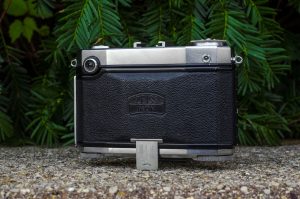
The back of the camera has an interesting ‘kickstand’ that is only necessitated as a result of the front door of the camera that when open, goes beyond the bottom plate of the camera. Without this kickstand, if you wanted to set the camera down on a table with the lens open, it would be perpetually pointed at an upward angle. To use the kickstand you simply pull down on it until it stops, but to put it back in, you’ll notice that there is a curved arrow engraved into the metal which is telling you that you must put left to right sideways pressure on it while pushing it back up into the body of the camera. This tricked me the first time I handled the camera as I struggled to get it back in. The kickstand feature is nice, but as I said before, had Zeiss come up with a better design to the door, this wouldn’t have been necessary at all.
The only other things you’ll see on the back of the camera is a nice embossed Zeiss-Ikon logo on the door, the viewfinder in the upper left corner, and a meter calibration screw used to zero the meter if needed. Perhaps speaking to the excellent build quality of the camera, although my example showed signs of heavy use throughout it’s life, all of the leatherette looked good and was not peeling anywhere.
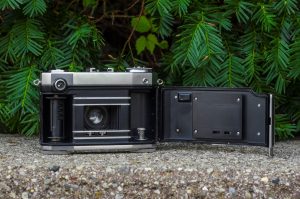
Loading film into the camera requires opening the door via a latch on the camera’s left side, but once the door is opened, you’ll see that film loads backwards of most 35mm cameras from right to left. Zeiss designed both the wind and rewind knobs on the bottom of the camera which required the film to be loaded in this way, but to be fair, it’s not really a big deal. The take up spool is non-removable and has a large slit covered by a chrome plate that you slide the leader into. It’s worth noting that the Contessa has two toothed gears beneath the film gate that are used to both release the double exposure lock, and also advance the non-resetting exposure counter on the bottom of the camera.
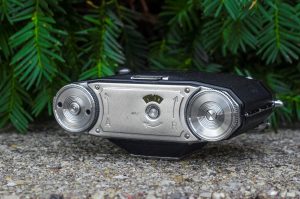
Speaking of the exposure counter, the bottom of the camera has two large wheels on each side, one for advancing the film, and the other for rewinding. The advance wheel has a button in the center that when pressed in, releases the rewind lock when you’ve reached the end of a roll of film. The previously mentioned exposure counter is in the center, and does not automatically reset when opening the back of the camera. Unlike the Kodak Retina, the Contessa’s exposure counter goes upwards, starting at 1 and stopping at the end of the roll.
The build quality is overall very good, possibly even better than the Retina. I think the Contessa has a superior rangefinder made of solid glass, and by using a rotating lens mounted to the shutter itself, there is no linkage to get bent or damaged when folding the camera. The door is a little better designed, and can be opened and closed regardless of the position of the focus setting of the lens, unlike the Retina which can only be closed with the lens set to infinity. I feel that these differences mean there’s less fail points than anything Kodak AG ever made.
The viewfinder is comparable in size and brightness to the Retina IIa which would have likely been this camera’s main competitor so if you were in the market for one of these two cameras in the early 1950s, that likely wouldn’t have been a deciding point. For me, the usability of the Contessa really bothered me. The cramped placement of the controls caused me to constantly pull the camera away from my eye making shooting this camera a chore. I never got used to it, and I felt like I had to force myself to keep picking up this camera to finish the 24 exposure test roll. Thank goodness I didn’t load a 36 exposure roll in it!
My overall experience through my test roll was not positive. Sure, the camera feels solid and well made in your hands. I can appreciate the effort Zeiss went into designing a rangefinder that was cutting edge when this camera was new. Plus, selenium cell exposure meters were not standard equipment in 1950 when this model first debuted so that was an obvious plus. The Retina didn’t have a metered model available until 1954, so from a technology standpoint, Zeiss did all they could to cram as much of it into a body as small as possible. I think there gets to a point where usability takes a backseat to design and that’s what happened here. As a collector with access to as many cameras as I do, is there enough good about this camera to overlook the bad? How will the images look?
My Results
I loaded up the Contessa 35 with some expired Kodak Gold 200 and took it with me on everyday adventures in late summer of 2016. I felt as though the compact nature of the camera meant I should use it as it might have been used when it was new. A easy to carry, but high quality, snapshot camera.
Cameras like the Zeiss Contessa 35 which have a reputable name behind them often produce predictably good results. Like the Kodak Retina series that I continually compare this camera to, the Contessa gave me a roll back with mostly great images. There were a few that were blurry, likely due to the rangefinder being a tad off, but otherwise I was mostly happy with the images it made.
While I would generally consider myself a fan of the whole Retina series, I don’t find myself drawn to using them regularly. While they are mechanical marvels, their compact size and German design often get in the way of usability. I feel the same way about this camera.
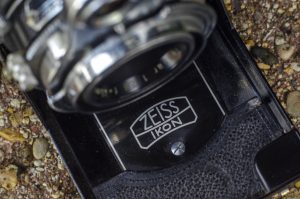
The Zeiss-Ikon Contessa 35 is an example of a camera where I enjoyed it’s history a lot more than the camera itself. In reading various other reviews of this model online, each of my complaints is often repeated, however I seem to be in the minority in that I generally didn’t care for this camera. That’s not to say the Contessa is a bad camera, because it isn’t. I did not care for the placement of the controls. The viewfinder, while acceptable for the era, is smaller and darker than rangefinders that came a mere 5 years after this model was released. The trapezoidal view makes for some guesswork compositions.
Zeiss had a tough task coming up with something from scratch after the war, in a small factory that didn’t have the capacity to build compact 35mm cameras. The Contessa has a lot of features and was a state of the art camera at the time. Hubert Nerwin accomplished his goal of creating a feature packed and high quality compact 35mm camera. My issues with it are strictly usability, and likely someone in the 1950s might not have complained about. Thankfully, the camera is quite attractive and will look good on my shelf…a place it will likely remain for a long time.
My Final WordHow these ratings work |
The Zeiss-Ikon Contessa 35 was the third new camera produced by Zeiss-Ikon’s Stuttgart factory after the war. It was designed by Hubert Nerwin, who also designed the Ikonta 35, Contaflex, SLR, Contax II, and Tenax cameras. The Contessa primarily competed with the Kodak Retina and shares it’s compact size. The 4-element Tessar lens is very capable of excellent images, and with features like a selenium meter, and rotating rangefinder glass that did not need a mechanical connection back to the viewfinder, the camera was full of state of art technology for the time. Unfortunately, due to the size of the camera, all of the cameras controls are cramped together and difficult to use. While I agree this is a well built and gorgeous camera, I did not enjoy using it. | ||||||
| Images | Handling | Features | Viewfinder | Feel & Beauty | History | Age | |
| 1 | 0 | 2 | 1 | 2 | 0 | 30% | |
| Bonus | none | ||||||
| Final Score | 7.8 | ||||||
Additional Resources
http://camera-wiki.org/wiki/Contessa_35
https://www.cameraquest.com/contessa.htm
https://mikeeckman.com/photovintage/vintagecameras/contessa35/index.html
https://www.photo.net/discuss/threads/zeiss-ikon-contessa-35-533-24.441056/
http://www.amateurphotographer.co.uk/forums/threads/zeiss-ikon-contessa-35.112861/
http://elekm.net/pages/cameras/contessa.htm
http://silfver.blogspot.com/2006/07/zeiss-ikon-contessa-35-folding-beauty.html

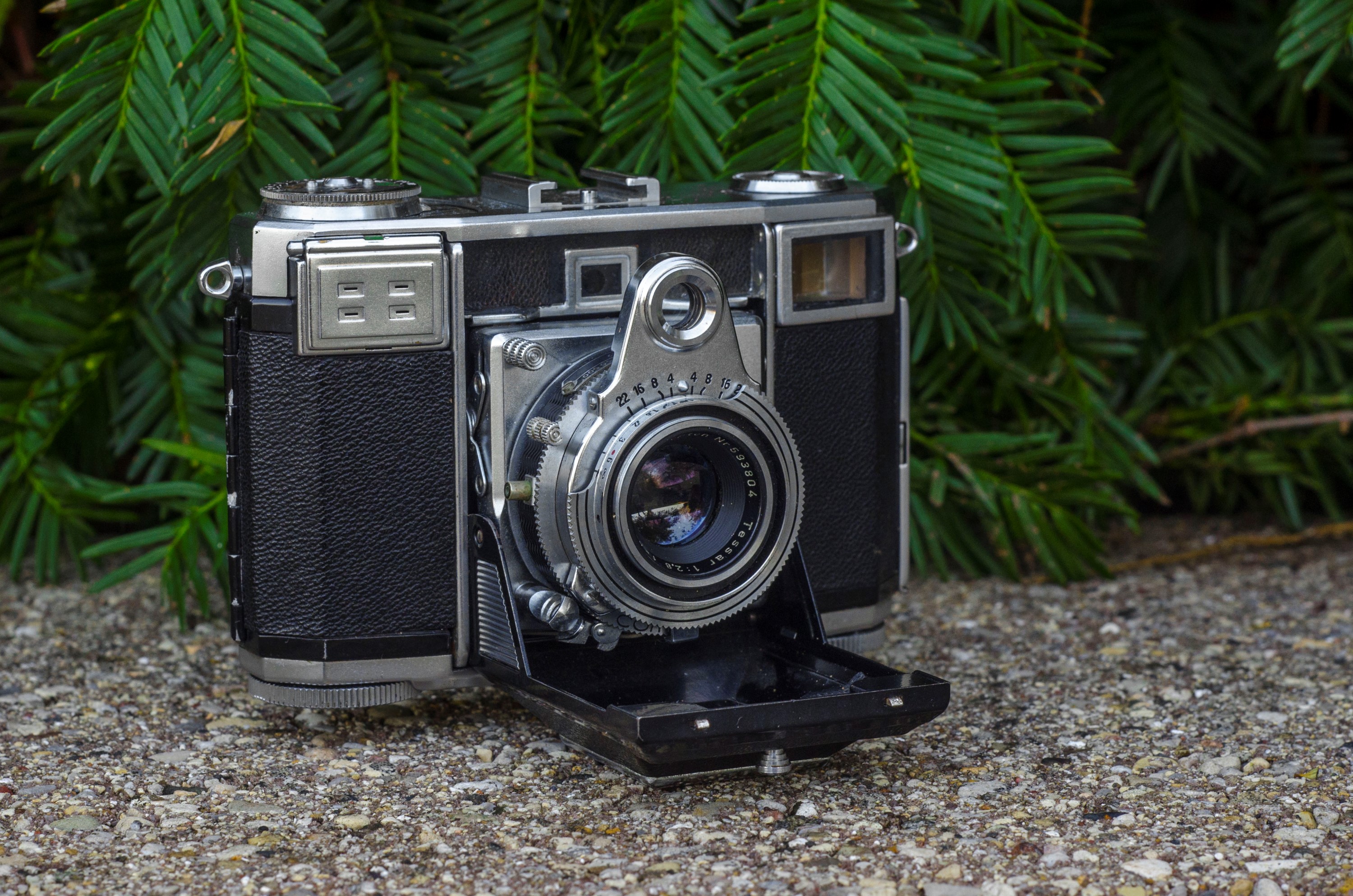
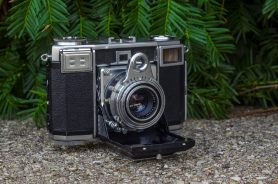
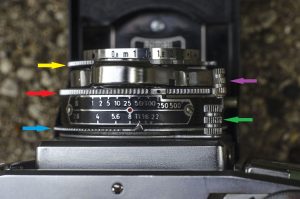








Mike, another great review. I got my Contessa 35 for my birthday last November. While I do agree on the handling of the camera, with practice and use, I got use to all its quirks. It has found a spot in my ever growing bag. I was surprised to find the meter still works as intended, 68 years later. I did shoot a few rolls using the meter, and although it is close enough, I mainly shoot it using sunny 16.
Thanks for a very fine review of this excellent classic. My feelings on the usuability are a little less severe. I do enjoy using it, but find it often a PITA for the same reasons.. I’m just a little more forgiving. My exemplar came in to my possession early on. My first trip to Germany in 1988/9 while near Stuttgart I visited a shop where this was available for 300,00 DM.. I recall offering him less money but he pointed to the price as if I couldn’t read it.. so much for bartering 🙂 I was already in possesion of a similar vintage Ikonta 532/16 and enjoyed showing people both models.. Father and son, I joked. Only 20 years later did I finally buy a Nagel camera and … wow.. their build quality is equally amazing.
I’ve always blamed that trapezoidal slanted view on the RF not understaning perhaps the RF design. I am always pleased with the results, All things considered the Contina II (Tessar) delivers equally good results. My meter also seems to work, but like Anthony I just trust my Sunny F16. I found an advertising phamphlet (black and red) on-line with a minimalised pen/ink drawing of an elegant lady.. which implied to me anyway , that this may have been marketing to..well, elegant lady shooters. My model is also so well used that the text on the face is faded. I guess I just feel privileged to be using such a thing that the obvious faults that you point out ,detracting from use, I’m willing to overlook.
BTW.. you should review the Contax one of these days!!
I’ve found that nearly all Contessas out there for sale look heavily used and worn, suggesting that the target buyer for these cameras used them often. I don’t know if that’s a pro for the camera or a con, as sometimes I find that mint condition cameras are more stiff and have issues, whereas the “battle used” models often work just fine. I’ve passively been looking for another Contessa to try again after my original one from this review (which I have since flipped), to see if perhaps I might have a more favorable experience with another example. I’ll be sure to update this review if I ever do!